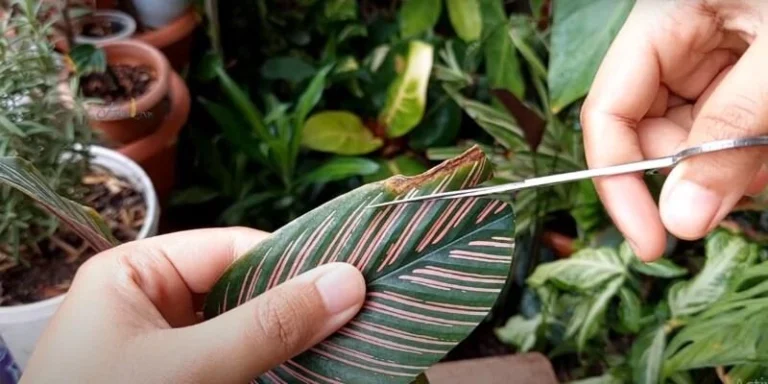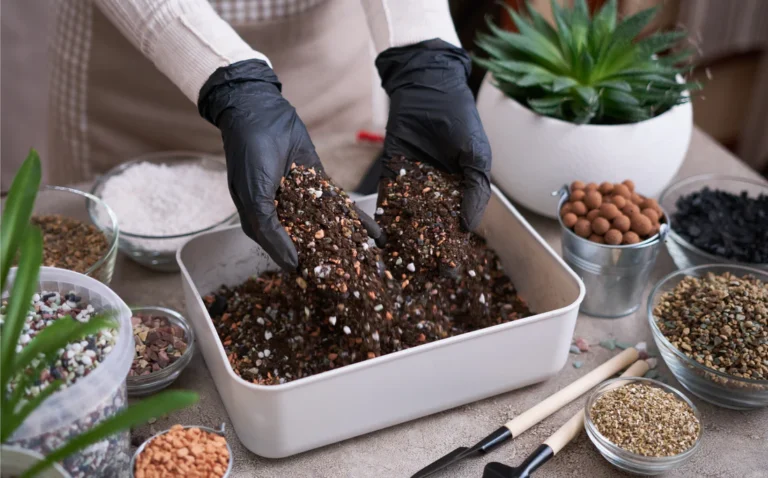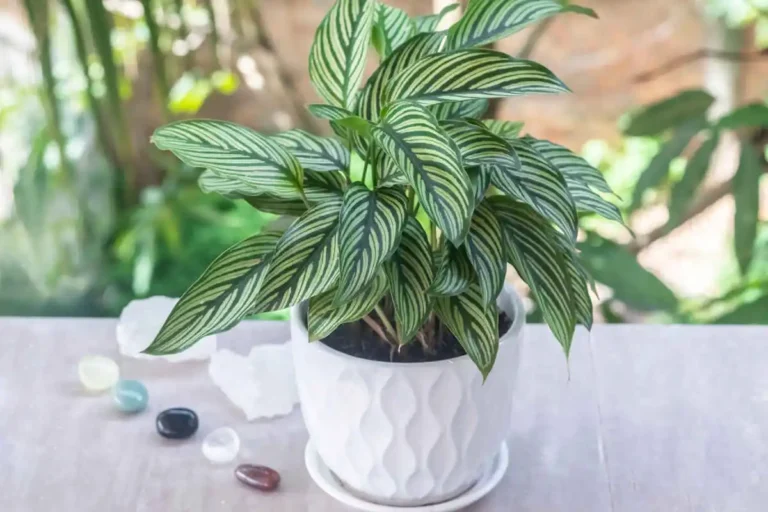How to Save a Dying Calathea Plant? A Step By Step Guide
Calathea plants, known for their striking leaf patterns and colors, flourish extraordinarily in a favorable ideal environment. However, these indoor plants sometimes show a decline, leaving plant lovers wondering how to save a dying Calathea plant.
But fear not! Suppose you find your Calathea rapidly wilting, fading, and losing leaves. In that case, you can still revive it to vibrant life by ensuring enough lightning conditions, watering them when the soil is halfway dry, trimming away dead leaves, turning up the humidity to over 50 percent, adjusting temperatures to 64 to 75 degrees Fahrenheit, and treating pests and plant diseases.
The above pointers suggest that providing care is the best way to help an ailing Calathea heal. This article will guide you through the step-by-step process of identifying and addressing issues with Calathea, ensuring its revival and continued health.

Understanding Calathea’s Basic Needs
Calathea has specific care requirements, which, if not met, can cause a rapid decline in its health and appearance. These requirements include
Neglecting these needs will raise issues and lead to stress in the plant. Therefore, ensure such conditions to maintain a healthy Calathea.
Also check How to Care for a Calathea Plant?
What Are The Signs of a Dying Calathea Plant
Correctly diagnosing the signs of distress in Calathea and taking the necessary actions is crucial to its rescue. Common signs indicating that Calatheas are suffering include
Recognizing these symptoms before they have severe effects is crucial to reviving your Calathea plant successfully.

How to Revive Your Dying Calathea Pant? A Step-By-Step Rescue Process
Reviving a dying Calathea plant from distress involves a careful and attentive approach. Here is how I revived my dying Calathea plan:
1. Calathea Thrive Well in High Humidity
Calathea are moisture-loving plants and thrive when high humidity is around them. The average moisture they require ranges from 50 to 70 percent. Below 50 %, their leaves become crispy brown at the edges and tips. Prolonged exposure to dry weather evaporates water from their leaves’ surface, and they start wilting and drooping, and the plant dies.
To keep your Calathea plant fresh and lively, increase humidity by using:

· Plant Humidifiers: Their auto-cut on/off switches help maintain high humidity levels.
· Group Indoor Plants Together: Gather all humidity-loving indoor plants in a corner and place your dying Calathea plant between them. Due to the high transpiration rate, the plant gets the required humidity from the surroundings and starts thriving again.
· Pebble Tray With Water: Taking a deep tray, filling it with pebbles or stones, and pouring water into it is a natural homemade humidifier. Place your dying Calathea plant pot on the rocks and ensure the required humidity.
· Misting: Misting your plant twice to thrice daily can fulfill humidity requirements. However, it is slow and less effective and can also invite leaf fungal diseases.

2. Adjusting Watering Techniques – Save Calathea from Overwatering and Underwatering
How to Save a Dying Calathea Plant in Water? Adjusting the watering pattern and drainage can save your dying Calathea plant. Here is how you can do this:
· Do Proper Watering: Water your Calathea plant when the top inch of soil is slightly dry. Avoid overwatering, as it can make the soil soggy, which leads to root rot. Allow the soil to dry out before the next watering.

· Select Well-Draining Soil: Choose a well-draining soil mix designed explicitly for Calathea plants to avoid waterlogging around the roots. Selecting a pot with proper drainage holes allows excess water to escape and ensures adequate moisture levels.

3. Get Your Calathea Out of Direct Sun to Avoid Scorchy Leaves
Calathea plants love to grow under bright, indirect sunlight, which you can ensure by:
· Avoiding Direct Sunlight Exposure: Place your Calathea where no direct sunlight reaches, as exposure to direct light can scorch the leaves.
· Place Them Near North or East-Facing Windows: North or East-facing windows provide gentle indirect light throughout, which is ideal for Calatheas. Avoid placing them near southern or western windows as they allow direct light exposure, which can dehydrate their leaves and turn them into pale, dried-up husks.
Thus, find the right balance of lighting conditions and help your Calathea regain its vibrant foliage.
4. Trimming and Pruning Damaged Foliage Encourages New Growth
To revive your dying Calathea plant, trim and prune its damaged foliage by:
· Removing Dead or Yellowing Leaves: Trim off completely brown, dead, or yellowing leaves to help your Calathea direct its resources where they’ll do some good. You can use clean, sharp scissors, pruning scissors, or disinfect the ordinary blades to reduce the risks of the cuts getting infected.
· Pruning Leggy Stems: Pruning back your Calathea’s long, leggy stems with sparse foliage encourages new growth and a bushier plant appearance.
5. Temperature Fluctuations Can Harm Your Plant
Indoor Temperature fluctuations can harm and kill the Calathea plant. Due to their tropical nature, Calatheas are less tolerant to cold temperatures. Therefore, ensure temperatures range between 65 and 80 degrees Fahrenheit for optimum growth.
Otherwise, Calatheas will restrict their growth, and their leaves will become yellow and white or show red spots near the veins.
Therefore, to revitalize your dying Calathea plant, avoid placing it near a heater or air conditioner and look out for cold drafts, like bathrooms with enough humidity.
6. Spotting Pest Signs Help Treat Diseases
While pruning off your plant, spot the signs of pest infestation on your Calathea plant by inspecting the lower side leaves and stem joints.
Pests commonly attacking Calathea plants include spider mites, fungus gnats, aphids, mealybugs, and sooty molds. The common signs of pest attack include a white powdery substance and webs on the leaves and stem, indicating that spider mites are sucking leaves’ sap.
You can treat the pest infestation by:
· Rubbing Alcohol: Pour some alcohol onto a cotton swab and rub it on the underside of the affected leaves. It will deter spider mites very quickly.
· Spraying Rosemary Oil: Rosemary oil is an insecticide and effective for spider mites treatment as they don’t love this oil.
·Neem Oil: Neem oil is an excellent pest repellent that can be mixed with a glass of lukewarm water and one tablespoon of castile soap.
7. Avoid Root Rot by Inspecting Plant Roots
Your Calathea plant may be suffering from overwatering issues. These issues cause the soil to become soggy, prevent roots from getting enough oxygen, and cause dehydration despite having much more water in its pot.
It also promotes bacterial and fungal attacks, which can sneak into the roots and cause Calathea to suffer from root rot.
Therefore, regularly inspect your plant roots and wash off the clinging soil to give them a thorough inspection. This technique will restore your Calathea to average growth.

8. Calathea Dying After Repotting Stress-Reduce Repotting Shock
The commercial potting soils you choose for your Calathea plants have surprisingly poor drainage capacity due to their fine particles, which results in overwatering.
So, repot your Calathea in a custom blend containing 40% coconut coir, 25% coarse-grain perlite, 10% vermicompost, and 25% orchid bark. Lightly moisten the potting mix until damp to reduce the repotting shock.

Giving your plant fresh soil is good as it gives it a new start, even if there are no signs of overwatering or root rot.
9. Show Patience and Persistence
Saving a dying Calathea plant requires you to show some patience and persistence. Do the following things while caring for your Calathea.
· Provide Consistent Care by adjusting the watering schedule and maintaining the optimum humidity and lighting conditions. Avoid sudden changes that can shock its growth.
· Monitor Your Calathea’s Progress and make necessary amendments when needed. Remember, each plant is unique; therefore, adapt your care plans accordingly.
· Give Time for Recovery: Reviving your dying Calathea plant takes a specific time. Therefore, be patient and allow your plant to recover and regain its lost health.

What to Do If Your Calathea Looks Completely Dead?
Believe it or not, your Calathea can still revive itself if all of its foliage has died, as it stores energy in unique root structures called rhizomes. They can spend this energy to restart their growth when everything above the ground has vanished. Thus,
Of course, this is an uncertain and time-consuming process, and Calathea doesn’t always recover from stress. Therefore, if you have lost your plant, start from the crash and learn from the experience to become a better indoor gardener.
Frequently Asked Questions
1. How long does it take to revive a dying Calathea?
Usually, it takes a month or two for Calathea to recover from the stress and develop new roots and foliage. Thus, show patience and persistence and provide your Calathea with a favorable growing environment of warm temperatures, high humidity, and exposure to medium indirect light.
2. Should you cut dead leaves and foliage off the Calathea?
Yes! It would be best to cut the dead leaves or foliage off the Calathea plant. Redirecting nutrients to the growing parts will improve the plant’s growth and appearance.
3. How do I bring my Calathea back to vibrant life?
You can bring your Calathea back to healthy life by ensuring a high-humidity environment. They are tropical plants and love to thrive in humid conditions. Thus, the humidity can be increased through regular misting of leaves, using a pebble tray, or moving a humidifier nearby.
Final Words
Saving a dying Calathea plant is challenging and requires proper attention and understanding of its needs. By identifying the signs of distress, adjusting proper care practices, and maintaining a copycat environment of the native land, you can bring your Calathea back to everyday life.
Adjusting proper lighting, watering, temperatures, humidity, and cutting off dead foliage ensures a thriving Calathea. Following these tips can make your Calathea vibrant and beautiful again.

About Author
Hi, I’m Emily Davis, a passionate tropical plant enthusiast dedicated to sharing knowledge and expertise with plant lovers. Through his blog, I will provide guides, tips, and tricks for caring for tropical houseplants species like Alocasia, Anthurium, Calathea, Philodendron, Begonia, and many more that will help readers bring a touch of paradise into their own homes. With a deep love for the vibrant colors and lush textures of tropical flora, I’m committed to inspiring others to cultivate their own tropical oasis.


![Types of Calathea Plants: 25 Varieties to Grow Indoors [with images] 11 Calathea](https://tropicalplantscare.com/wp-content/uploads/2025/04/Calathea-2-768x576.webp)



